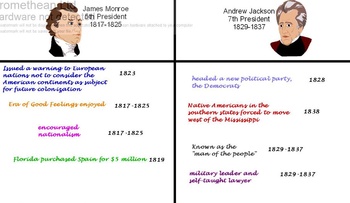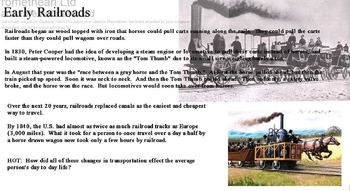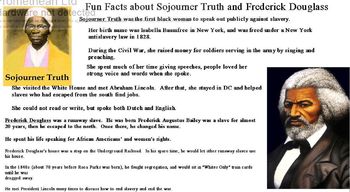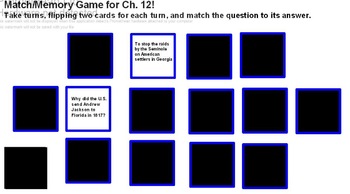Times of Change and Reform in the United States
EducPrek12
230 Followers
Grade Levels
5th - 7th
Subjects
Resource Type
Formats Included
- Flipchart File
Pages
58 pages
EducPrek12
230 Followers
Description
This flipchart is aligned with Scott Foresman Social Studies 5th Grade: The United States textbook and workbook Ch. 12: Times of Change. It is about 2-4 weeks worth of lessons/content for your history class. It contains: Lesson 1: The United States Turns Fifty, Lesson 2: A New Kind of Revolution, and Lesson 3: The Struggle for Reforms. It teaches events and historical figures of the early to mid 1800s, including: James Monroe, Andrew Jackson, Era of Good Feelings, American Indian Removal, inventions and changes of the Industrial Revolution, Second Great Awakening, Temperance Movement, Abolitionist Movement, Elizabeth Cady Stanton, Frederick Douglass, John Quincy Adams, Sojourner Truth, Lucretia Mott, women's rights, educational reform, suffrage, Seneca Falls Convention, etc. In addition to teaching concepts of main idea, compare/contrast, and reading a cross-sectional diagram.
Week 1, 13 slides (about 5 days worth of content)
The United States Turns Fifty
Lesson 1: This lesson opens with a title page, then a list of objectives to be covered throughout the unit. Next, it gives an opening activity to interactively teach students how to compare and contrast within a text. Next it gives a title page of the lesson with a picture of James Monroe, dates of his presidential term, along with a higher order thinking prompt. Next is a list of vocabulary terms: nationalism, Era of Good Feelings, Monroe Doctrine, suffrage, Indian Removal Act, Trail of Tears, along with their definitions. The next slide gives a summary of important facts of James Monroe's presidency. The next slide then gives a summary of Andrew Jackson and his presidency. Next, students are taught about the Indian Removal Act, along with a higher order thinking prompt. The lesson then presents the Trail of Tears along with a map demonstrating this with the Indian Removal. Next, students are shown a timeline summarizing events that they learned about in lesson 1. The lesson then moves toward a vocabulary matching page, in which students can match the term to its definition. The next activity invites students to participate in the comparing and contrasting of James Monroe and Andrew Jackson: they are given a t-chart, one side for Jackson, and the other Monroe. At the bottom of the page are color-coded terms/events and time frames. The students, as a class, take turns dragging the appropriate terms or events under the president that it occurred, along with the year it occurred. I used this as a Kagan activity, in which their partner would check their accuracy.
Week 2, 16 slides (about 5 days worth of content)
A New Kind of Revolution
Lesson 2: A New Kind of Revolution opens with a title page giving students rich visual of the Industrial Revolution, along with introductory statements and a higher order thinking prompt to get started. Next, students are given vocabulary terms along with their definitions: Industrial Revolution, manufacture, technology, cotton gin, mechanical reaper, and canal. The next page has a large picture of inside a factory in the 1700s, along with information about how the Industrial Revolution began and important people that made it possible, and concludes with a critical thinking question. The next slide visually demonstrates and explained how inventions of the Industrial Revolution changed factories and farms, with bullet points and a chart showing cotton production in the U.S. from 1800-1850. The next couple of slides teach about the changes in transportation at this time along with pictures. The lesson then gives a timeline of events from this lesson. The lesson then moves toward a vocabulary matching page, in which students can match the term to its definition. Next is a game on the inventions of the Industrial Revolution. For each slide, a picture of an invention is shown and the students are asked 3 questions: who invented it, what happened before the invention, and a benefit of the invention. Teachers can implement this activity in a variety of ways. I chose to put my students in groups of 2-3, and they collaboratively answered the questions (1 student per question) and checked themselves as a group, then had a student come up to the board and reveal the answers. This game addresses 7 important inventions of the Industrial Revolution. Next, students learn about cross-sectional diagrams and how to read them. Their workbook will have them read a cross-sectional diagram on the cotton gin, so for practice, I presented them with a picture of a heart and questions about how it works so students could get a feel for this skill.
Week 3, 29 slides (about 5 days worth of content)
The Struggle for Reforms
Lesson 3: The Struggle for Reforms lesson opens with a title page of a picture of Elizabeth Cady Stanton, information bullets, and an introductory prompt. Next, students are given vocabulary terms along with their definitions: reform, revival, temperance, abolitionist, and Seneca Falls Convention. The lesson then moves into the Second Great Awakening, with information from that time and a critical thinking prompt. Next, the lesson address the fight against slavery, discussing Frederick Douglass, John Quincy Adams and other members of anti-slavery groups. The lesson moves onto women’s rights and important figures of this time. It also discusses resolutions from the Seneca Falls Convention and the press this convention received at the time, with a couple of higher order thinking prompts. The next slide discusses the spirit of reform and all of the conditions reformers wanted to improve: slavery, education, women’s rights, treatment of the mentally ill, etc. Next, gives students fun facts about figures Sojourner Truth and Frederick Douglass. Next, it shows a timeline of events from lesson 3. The lesson then gives a timeline of events from this lesson. The lesson then moves toward a vocabulary matching page, in which students can match the term to its definition. Next is a memory game students can play for Ch. 12, they take turns going up to the board and flipping two cards at a time, they must flip the question and its answer to get a match. The next several slides are a vocabulary review of Ch. 12, students are invited to take out their marker boards and write the answers, and when the teachers calls “show down” they hold their boards up high, and the teacher shows them the answer. The next page then allows for review and closure asking students to give 3 important things they learned from Ch. 12. The final page is a project-based learning activity inviting students to choose from 1 of 3 journal prompts, example, “Write a letter that a soldier witnessing the Trail of Tears might have written to his family.”
Week 1, 13 slides (about 5 days worth of content)
The United States Turns Fifty
Lesson 1: This lesson opens with a title page, then a list of objectives to be covered throughout the unit. Next, it gives an opening activity to interactively teach students how to compare and contrast within a text. Next it gives a title page of the lesson with a picture of James Monroe, dates of his presidential term, along with a higher order thinking prompt. Next is a list of vocabulary terms: nationalism, Era of Good Feelings, Monroe Doctrine, suffrage, Indian Removal Act, Trail of Tears, along with their definitions. The next slide gives a summary of important facts of James Monroe's presidency. The next slide then gives a summary of Andrew Jackson and his presidency. Next, students are taught about the Indian Removal Act, along with a higher order thinking prompt. The lesson then presents the Trail of Tears along with a map demonstrating this with the Indian Removal. Next, students are shown a timeline summarizing events that they learned about in lesson 1. The lesson then moves toward a vocabulary matching page, in which students can match the term to its definition. The next activity invites students to participate in the comparing and contrasting of James Monroe and Andrew Jackson: they are given a t-chart, one side for Jackson, and the other Monroe. At the bottom of the page are color-coded terms/events and time frames. The students, as a class, take turns dragging the appropriate terms or events under the president that it occurred, along with the year it occurred. I used this as a Kagan activity, in which their partner would check their accuracy.
Week 2, 16 slides (about 5 days worth of content)
A New Kind of Revolution
Lesson 2: A New Kind of Revolution opens with a title page giving students rich visual of the Industrial Revolution, along with introductory statements and a higher order thinking prompt to get started. Next, students are given vocabulary terms along with their definitions: Industrial Revolution, manufacture, technology, cotton gin, mechanical reaper, and canal. The next page has a large picture of inside a factory in the 1700s, along with information about how the Industrial Revolution began and important people that made it possible, and concludes with a critical thinking question. The next slide visually demonstrates and explained how inventions of the Industrial Revolution changed factories and farms, with bullet points and a chart showing cotton production in the U.S. from 1800-1850. The next couple of slides teach about the changes in transportation at this time along with pictures. The lesson then gives a timeline of events from this lesson. The lesson then moves toward a vocabulary matching page, in which students can match the term to its definition. Next is a game on the inventions of the Industrial Revolution. For each slide, a picture of an invention is shown and the students are asked 3 questions: who invented it, what happened before the invention, and a benefit of the invention. Teachers can implement this activity in a variety of ways. I chose to put my students in groups of 2-3, and they collaboratively answered the questions (1 student per question) and checked themselves as a group, then had a student come up to the board and reveal the answers. This game addresses 7 important inventions of the Industrial Revolution. Next, students learn about cross-sectional diagrams and how to read them. Their workbook will have them read a cross-sectional diagram on the cotton gin, so for practice, I presented them with a picture of a heart and questions about how it works so students could get a feel for this skill.
Week 3, 29 slides (about 5 days worth of content)
The Struggle for Reforms
Lesson 3: The Struggle for Reforms lesson opens with a title page of a picture of Elizabeth Cady Stanton, information bullets, and an introductory prompt. Next, students are given vocabulary terms along with their definitions: reform, revival, temperance, abolitionist, and Seneca Falls Convention. The lesson then moves into the Second Great Awakening, with information from that time and a critical thinking prompt. Next, the lesson address the fight against slavery, discussing Frederick Douglass, John Quincy Adams and other members of anti-slavery groups. The lesson moves onto women’s rights and important figures of this time. It also discusses resolutions from the Seneca Falls Convention and the press this convention received at the time, with a couple of higher order thinking prompts. The next slide discusses the spirit of reform and all of the conditions reformers wanted to improve: slavery, education, women’s rights, treatment of the mentally ill, etc. Next, gives students fun facts about figures Sojourner Truth and Frederick Douglass. Next, it shows a timeline of events from lesson 3. The lesson then gives a timeline of events from this lesson. The lesson then moves toward a vocabulary matching page, in which students can match the term to its definition. Next is a memory game students can play for Ch. 12, they take turns going up to the board and flipping two cards at a time, they must flip the question and its answer to get a match. The next several slides are a vocabulary review of Ch. 12, students are invited to take out their marker boards and write the answers, and when the teachers calls “show down” they hold their boards up high, and the teacher shows them the answer. The next page then allows for review and closure asking students to give 3 important things they learned from Ch. 12. The final page is a project-based learning activity inviting students to choose from 1 of 3 journal prompts, example, “Write a letter that a soldier witnessing the Trail of Tears might have written to his family.”
Total Pages
58 pages
Answer Key
N/A
Teaching Duration
3 Weeks
Report this resource to TPT
Reported resources will be reviewed by our team. Report this resource to let us know if this resource violates TPT’s content guidelines.





